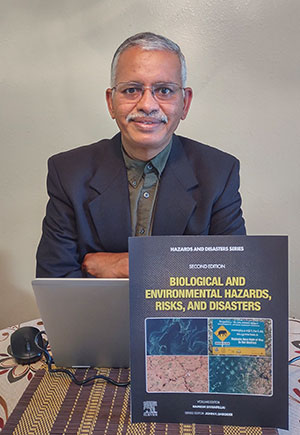UW Research Scientist Edits Book About Biological and Environmental Hazards
Published July 07, 2023

Ramesh Sivanpillai is no stranger to biological and environmental disasters, having provided crucial U.S. Geological Survey mapping data to aid in response to Hurricane Fiona in the Dominican Republic during 2022; to control the 2018 wildfires in Paradise, Calif.; and to assist in the response to widespread flooding in several Midwest states in 2011.
So, it should come as no surprise that Sivanpillai, a University of Wyoming senior research scientist with UW’s Wyoming Geographic Information Science Center, was tapped to edit a book on natural disasters. “Biological and Environmental Hazards, Risks and Disasters” was published by Elsevier and released in June.
“This interdisciplinary book focuses on two types of hazards, risks and disasters: biological and environmental,” Sivanpillai says. “Authors from several countries and agencies have contributed to this volume, which is the second edition. This book is part of a series of books on hazards, risks and disasters.”
The book, overseen by series editor John Shroder, a professor emeritus of geography and geology at the University of Nebraska-Omaha, provides an integrated look at major impacts to Earth’s biosphere caused by diseases, algal blooms, insects, animals, species extinction, deforestation, land degradation, and comet and asteroid strikes, with important implications for humans.
This second edition from Elsevier’s “Hazards and Disasters Series” incorporates perspectives from the natural and social sciences to offer in-depth coverage of threats from microscopic organisms to celestial objects and their potential impacts. Expert biological, health, ecological, environmental, wildlife, physical and health scientists contributed to the book. Readers will gain valuable insights on damages, causality, economic impacts, preparedness and mitigation.
Key features of the book are that it provides interdisciplinary and multidisciplinary research accessible to both specialists and nonspecialists; includes newly added chapters on emerging hazards and risks to Earth’s ecosystems -- land conversion and habitat loss -- and human health or spread of diseases; and contains full-color tables, maps, diagrams, illustrations and photographs of hazardous processes.
The book has plenty of examples and information about real-life disasters and risks. These include harmful algal blooms on water quality, aquatic life and humans in the U.S., Canada and other countries; grasshopper infestations in North America and Senegal; locust outbreaks in Australia and Central America; coral bleaching in Australia’s Great Barrier Reef; and wildlife-human conflicts involving mountain lions, bears, elephants, wolves, tigers, leopards, lions, hippopotamuses, zebras, spotted hyenas, crocodiles, snakes, jellyfish and sharks in various parts of the world.
Additionally, the book covers threats to mangrove ecosystems due to hurricanes, wind, tsunamis, sea level rise and various diseases; reduction of the Aral Sea, located on the border between Kazakhstan and Uzbekistan, to a fraction of its original size due to water diversion projects in two rivers that flowed into this water body; degradation of rangeland ecosystems; and threats Earth faces from meteors.
Sivanpillai says he assumes he was invited to edit the first edition of the series in 2013 because of his multidisciplinary background in environmental science. In 2019, Elsevier invited him to update the first edition with additional topics in new chapters.
“For the second edition, I had to find several new authors in several disciplines -- biology, ecology, entomology, biodiversity, algal blooms, coral bleaching, diseases, land degradation, Aral Sea disaster, ionizing radiation and meteor impacts -- that are not included in other volumes,” Sivanpillai says.
However, the process was not easy -- the project started a few months before the COVID-19 pandemic lockdowns, Sivanpillai says. He admits that it was difficult to find authors and to stay in regular communication with them.
“It was a struggle to get to the finish line,” he adds.
Sivanpillai did receive some much-needed help from UW students Emma Jones, of Papillion, Neb., and Claire Wooden, of Cody. Both are majoring in environmental and natural resources and were enrolled in Sivanpillai’s “Environmental Policy, Conservation and Development in India” course during spring 2021.
The two, along with Sivanpillai, co-wrote a chapter in the book about the sacred groves of Kerala in India. Sacred groves are places of religious significance, but most of them also serve as conservation sites for rare plants, insects, animals and birds.
“They did an outstanding job, and I invited them to submit their findings as a chapter,” Sivanpillai says. “Later, we worked with a faculty member in an Indian institution who added additional context to the chapter.”
Sivanpillai surmises that the audience base for the book is broad. Reasons he cites include the multidisciplinary nature and the range of topics covered in the book; the number of chapter downloads from Elsevier’s website to date; and the number of requests made from institutions that do not subscribe to Elsevier.

